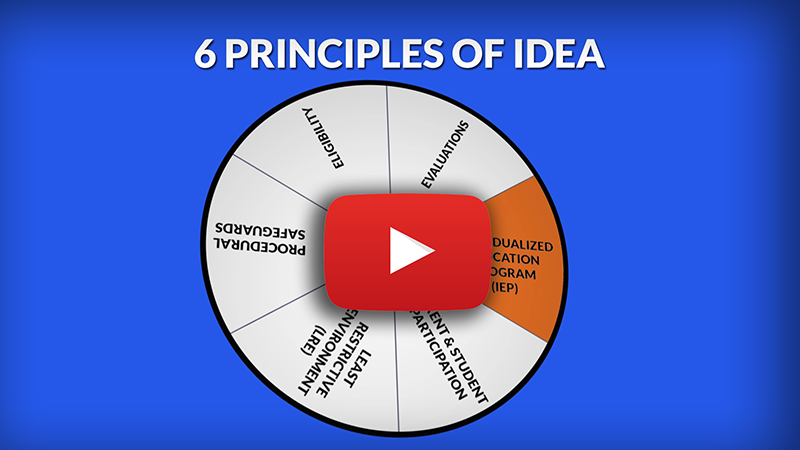6 Principles of IDEA: IEP
SUMMARY
Once a student has been determined eligible for special education services, an Individualized Education Program (IEP) is drafted for the student. This written document spells out your child’s learning needs, the services the school will provide, and how progress will be measured.
Creating an effective IEP takes time, effort and patience. The more you know about the process, the better you can advocate for your child. The term “IEP” is often used interchangeably to mean the formal document and the meeting in which it is discussed. To avoid confusion, it’s helpful to refer to the written document as the “IEP,” and the meeting as the “IEP Meeting” or “annual review.”
The IEP team is comprised of people who fulfill at least one of the following roles. Some team members may fulfill multiple roles.
- Parent/guardian of the child
- Special education teacher or special education provider
- General education teacher (if the child is, or may be, participating in the general education environment)
- A person who can interpret instructional implications of test/evaluation data, and
- A district representative
Components of the IEP
- PLAAFP. A statement of your child’s Present Level of Academic Achievement and Functional Performance (PLAAFP). This is a snapshot of who the child is and how they are currently performing.
- Parent Input. This is your opportunity to share insights about your child both academically and outside the school.
- Annual Educational Goals. These should be realistic, achievable and measurable. Goals can be academic, behavioral, social or transition-based, and should always be written for identified areas of need.
- Accommodations and Modifications. These are changes to that help your child learn the general education curriculum.
- FAPE (Free and Appropriate Public Education). FAPE is the public school district’s offer of services and supports in the least restrictive environment (LRE) that your child needs to reach the identified goals and how they’ll be delivered. There should not be variable terms, such as “as needed"; instead, the FAPE section should spell out the minimum number and times for provision of services.
- Transition Plan. Students who will turn 15 must have a transition goal and plan to prepare them for life after high school.
The date of your annual meeting is based upon the initial IEP date. This means that if the initial IEP was completed in October, your annual date will be in October, not at the beginning of the school year. Remember that the IEP is a working document and can be modified and changed as needed throughout the school year. It is important to keep the line of communication open between team members and to continuously work together to best meet the needs of each student. You can request an IEP meeting at any time throughout the school year if you feel there is an issue that must be resolved by the IEP team.
Including your child in the IEP
If your child is young, you may want discuss the best way to include your child in the IEP meeting with your IEP team. Consider your child’s age, how their disability affects them, their level of maturity and their ability to understand the information discussed during an IEP meeting.
At age 15 and older, each student is required to participate in the process. Students are invited to attend the meetings; if they do not or cannot, then the team will find another way to allow participation, usually by going over the document prior to the meeting.
IEP team member attendance
Attendance at IEP meetings is required by those listed above, with one exception: A team member may be excused for all or part of the meeting when the related area of service or curriculum is not being discussed or modified, and the parent agrees in writing with the school district that the member is excused from the meeting.
If the related area of service or curriculum is being discussed, these criteria must be met for a team member to be absent:
- prior to the meeting the team member gives written input into the development of the IEP, and
- the parent agrees in writing with the school district that the member may be released from the meeting.
The IEP signature page
Each member of the IEP team signs the document to indicate that they were present at the meeting. Some parents believe that the parent signature is required on all IEPs before the document can be implemented, but this is not true in most states (including Colorado).
Related Resources
-
Description of how the five IEP team member contribute to the IEP process, including detailed parent responsibilities
-
Interactive video from the Colorado Department of Education
-
www.jeffcotag.info is a website dedicated to the six areas of Life After High School for a child with a disability, including transition components of an IEP.
-
Understanding the recent Supreme Court ruling about free and appropriate public education.
THE 6 PRINCIPLES OF IDEA
Use the buttons below to navigate to a detail page for each topic.


